Reviews
Robert Altman
USA, 1971
Credits
Review by Leo Goldsmith
Posted on 14 August 2009
Source Warner Brothers DVD
Categories Women of the West
Traveling lady,
stay a while
until the night is over.
I’m just a station on your way;
I know I’m not your lover.
—Leonard Cohen, “Winter Lady”
Like the vial of opium, dazzling and detailed, that captures Julie Christie’s attenuated attention at the close of the film, McCabe & Mrs. Miller is a curious object, one whose reputation has matured remarkably from appropriately grubby beginnings into a full-fledged classic. A film branded as “self-indulgent, rancid, perverse” by the Christian Science Monitor upon its release, rumored to have been dubbed “corrupt” by John Wayne himself, it has subsequently been heralded as the eighth greatest American Western of all time by the tepid, toothless listmakers of the AFI. Roger Ebert even calls the film “perfect.” But it is a strange, imperfect sort of perfection. Lamplit and ramshackle, stained brown and worn threadbare, McCabe & Mrs. Miller is an odd take on the genre — or, indeed, an odd take on the notion of what a film is or ought to be.
There are the oft-noted familiar genre tropes: a lonesome stranger, a gold-hearted hooker, a trio of grotesque assassins. Even the townspeople, homely and humble with a cowardly indifference imported from High Noon, fit in with the familiar notion of the expanding frontier, simple folk caught in a tooth-and-nail grapple with the land and the elements to effect civilization in the vast, untutored, untamable West. But Altman’s sense of Manifest Destiny resides not in the great, open plains or the totemic grandeur of Monument Valley This is a tale of the dank and misty crevices of the lost Pacific Northwest, of a town cynically (or hopefully) dubbed Presbyterian Church, WA, a collective of skeletal hovels, of which the actual, unfinished church is by far the least popular. Similarly, Altman’s film is less a satisfaction of narrative rhythms and archetypes than a story half-remembered, buried in time, in opiate indifference, that’s all the more melancholy for its diffusion.
Hollywood lore has it that Altman, having wooed Warren Beatty with the prospect of a project for the star and his girlfriend, Julie Christie, rode his production caravan north of Los Angeles to Vancouver. Adapting a conventional and otherwise entirely forgotten novel by Edmund Naughton, Altman and screenwriter Brian McKay (along with Beatty himself, who added much material) mean to tell the simple story of gambler, entrepreneur, and possible obscure gunslinger John McCabe, the birth of his saloon-whorehouse business, and his eventual partnership with the redoubtable, ambitious, and hard to read Mrs. Miller. This action takes place amid the drab and mud-filled streets of Presbyterian Church, a makeshift town that production designer Leon Ericksen and a local population of hippie draft-dodgers from south of the border built as the film was shot in sequence, a town in embryo that itself grows with the sub-suburban sprawl of the plot.
Contemporary reportage on the film’s production paint a portrait of Altman as the Timothy Leary of American independent cinema: a grisled magus swilling Cutty Sark and hitting a joint, and sporting a burly beard, love beads, turtleneck, and damp fedora. The local hippie-draft dodgers served as extras and crew, as well as simple inhabitants of Altman’s brown-and-white movie-world, and after a long day of commune-construction and myth(un)making they were encouraged to watch dailies and smoke grass in the director’s quarters. We get a sense of this hazy, friendly atmosphere from McCabe’s first, haughty entrance into squirrelly Sheehan’s saloon: the kind of communal palling around, as in a Howard Hawks movie, with just a little less joy and backslapping in the camaraderie and bonhomie. No stranger to gambling tables and “sporting houses,” Altman cultivated in his real and fictive Presbyterian Church an ambience of gentle squalor, warm and comforting in its disrepute, a home for traveling ladies, illiterates, latter-day cowboys, and desperate men. “I guess I have a great deal of affection for fools,” he once said. “I consider myself one.”
Unfortunately, Beatty agreed. Altman’s willful recklessness alarmed the star as a recipe for box-office suicide (which is, you might say, painless): his conspiring with cinematographer Vilmos Zsigmond to use heavy fog filters and flashing the negative in order to create a unique, but completely irrevocable look pitches the film into a remote and muddy past, which would be untouchable by meddlesome studio executives in postproduction.1 The soundtrack, too, was an offense to clarity, even for a director known for the complex aural canvases multitracked in M*A*S*H. Here, the effect was inadvertent, apparently the result of inclement weather and Altman’s disinterest in doing retakes and overdubs. But Beatty eventually flexed his industry muscles on this point, insisting on dubbing several lines in a manner that now seems far sloppier than the more naturalistic sound-collage of the rest of the film.
These few awkward rumples aside, Beatty is excellent in the film—whatever his beef with Altman’s working methods, many (including Altman and Christie) think McCabe is his best role. It certainly is the film that most fully captures the actor’s weird combination of awkwardness and bravado, hot-air and hotness. Burping oaths, muttering colorful insults (“you goddamn butternut muffdiver”), slurping his signature double-whisky-and-raw-egg cocktail, and tossing around nonsensical bawdy jokes (“You git me?”), Beatty makes McCabe a man of charming, dunderheaded bluster, only then to lay bare his raw sensitivity when Mrs. Miller calls him out on his cheap jockey club cologne or his deficiencies in basic arithmetic. Later, when Constance is fully in both his employ and his heart, McCabe must still pay his $5 to bed with her.
McCabe’s reaction to this kind of treatment from his partner and paramour is usually to get revoltingly drunk, a reaction that represents, not so much his emasculation, as the alienation of McCabe from his own business (“Madam, I am not here as a customer”) and therefore from his sense of self. Cornered by capitalist fat-cats, wooed by a self-righteous abstract acolyte of truth and justice, and finally menaced by the trio of company-paid thugs, McCabe feels the need to prove himself, first as the shrewd businessman he is not, then as the rumored gunslinger he is even less. McCabe’s true status is that of romantic and fool, but his affiliation with Mrs. Miller - as denoted by the ampersand which separates their names in the film’s title - is strictly business, suggesting an unbridgeable gap between them through which flows much money and a few cautious, loving glances. “Just one time,” McCabe declares to an absent Constance while strapping on a pistol, “you could be sweet without no money around. I think I could—well, I tell you something: I got poetry in me!”
But if Mrs. Miller sees this poetry in him, we barely know it—she’s the frizzy-haired, inscrutable center of the film, with eyes alternately clouded by opium and clarified by ambition. Like that of Bergman’s Fanny and Alexander, the title of McCabe & Mrs. Miller also posits its hero as one half of an inseparable duo of which other part is largely absent. We have McCabe, our de facto hero, and his mysterious better half, the silken shadow of Beatty’s gassy self-made man. Constance Miller’s provenance is unknown - and her marital status seems unlikely, given her profession - but her venture capitalism is what drives Presbyterian Church further into the twentieth century, as Paul Arthur notes in his essay on the film:
In its wake, the burgeoning whorehouse brings better housing, better hygiene and clothing, specialty retail stores, and a modicum of middle-class music and dance…. [T]he engine of progress, aka Manifest Destiny, appears to hinge on the supply-and-demand dynamics of an exploited female orifice.2
Miller’s mercurial role as madam, mother, and master builder of this town jangles with her isolating self-medication, a double-nature that, like McCabe’s, makes her both central to and distant from the rest of Presbyterian Church. But unlike McCabe, whose story ends in a more cowardly, more haphazard variation of the usual final showdown, Miller has no generic hero narrative to fall into. She is a denizen of the world of fallen womanhood, like one of Leonard Cohen’s traveling ladies: running for the money and the flesh; desired, desirous, and far from reach. Her status as woman and whore narrows her direct influence on Presbyterian Church, as well as on McCabe, and her engagement with each dissipates because of this. At the end of the film, as McCabe has his nearly heroic moment before collapsing in a snowdrift, Mrs. Miller simply turns away, turns inward.
As hard as it is to read this final act of turning on, tuning in, dropping out, it seems natural to align Mrs. Miller’s final disengagement with the director’s own, especially with our image of the heroic Altman in mind, Cutty Sark and joint at the ready. Having created this movie world — an entire town, a microcosm — to marvel at, and prescribed the yellow pot-haze through which to view it, the director zooms out and peers blankly, inviting or daring his audience to do the same. Along these lines, Jonathan Rosenbaum has written an interesting, hazy, and slightly dubious essay with the incriminating title, “What Dope Does to the Movies,” wherein he notes the influence of marijuana on Altman’s films, both their production and reception:
Drifting between … contradictory options, one navigated one’s way through Altman’s languid zooms and uncentered camera movements like a doper gliding through different trains of thought, comically stumbling (like many of the characters) through hallucinatory environments where nothing was ever the way one assumed it to be.3
Through Altman’s altered vision, we see McCabe’s mock-heroics as the drowsy Mrs. Miller might, as just one of many petty fumblings in the tapestry of human foolishness that is Presbyterian Church. We are adrift in a sea of tiny narrative possibilities, which the film picks up and discards: drunk Bart and his mail-order bride Ida; the smart, but marginalized black barber and his wife; Keith Carradine’s cheerful, then tragic cowboy. In any given viewing, we alight on some and not others, and Altman makes each of these stories, if not exactly full and fleshy, at least accessible to us as some small part of is dreary dreamscape. It is a narrow, but whole corner of the world, of history and myth, which we can enter, wander around in, and then leave behind, perfectly imperfect and corrupt.
- Zsigmond, a master of widescreen cinematography, had previously only worked on B-movies with titles like Horror of the Blood Monsters and Blood of Ghastly Horror, but leveraged his astonishing work with Altman here (and on The Long Goodbye) to lens some of the major (or at least most prominent) American films of the 1970s: Peter Fonda's The Hired Hand; John Boorman's Deliverance; Sugarland Express and Close Encounters of the Third Kind for Spielberg; both The Deer Hunter and Heaven's Gate for Michael Cimino; and later several De Palma films, and one or two of Woody Allen's shittier recent movies. McCabe remains his finest work, all thanks to the risky alchemical meddlings with the film stock. His rethinking of the color palette of the classical Western is far more influential than Altman's genre revisionism, inspiring an overwhelming percentage of subsequent work in the same milieu, especially that of Clint Eastwood. The aesthetics of Pale Rider and Unforgiven, in particular, are almost unthinkable without it.↩
- Paul Arthur, "How the West Was Spun: McCabe & Mrs. Miller and Genre Revisionism," Cineaste 28 no.3, Summer 2003.↩
- Jonathan Rosenbaum, "What Dope Does to the Movies."↩
More Women of the West
-
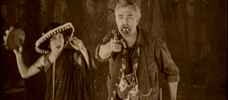
49-17
1917 -
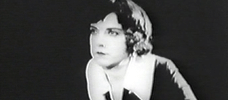
The Gun Woman
1918 -
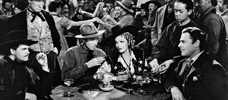
Destry Rides Again
1939 -
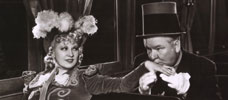
My Little Chickadee
1940 -
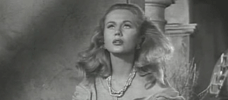
Colorado Territory
1949 -
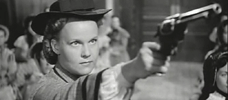
Westward the Women
1951 -
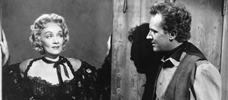
Rancho Notorious
1952 -
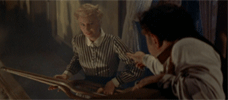
The Violent Men
1955 -
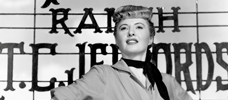
The Furies
1950 -

The Last Sunset
1961 -
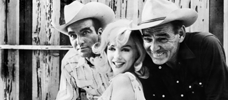
The Misfits
1961 -
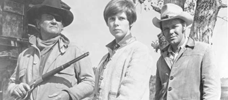
True Grit
1969 -
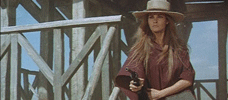
Hannie Caulder
1971 -
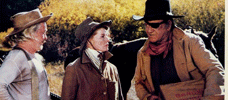
Rooster Cogburn
1975 -
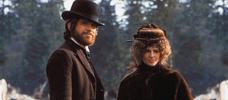
McCabe & Mrs. Miller
1971 -
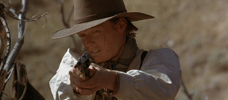
The Ballad of Little Jo
1993 -

The Quick and the Dead
1995 -
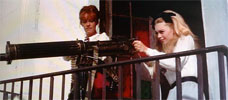
Viva Maria!
1965 -
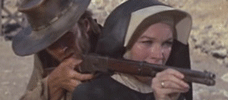
Two Mules for Sister Sara
1970
We don’t do comments anymore, but you may contact us here or find us on Twitter or Facebook.



